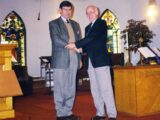On Feb. 13, 2022, six months before Hurricane Fiona struck the east coast, the members of Hillcrest United Church in Montague, P.E.I., gathered to celebrate the completion of a renovation project. The elegant white-sided building with its steeply sloped roof and gabled bell tower had been carefully maintained since its construction in 1909. The work being celebrated wasn’t flashy; it could easily have gone unnoticed by a visitor. But it felt monumental to the congregation members who had spent the past few years digging into their pockets, applying for grants, and lending time and muscle to the work. Together they had installed heat pumps, replaced windows, put in LED lighting, sealed air leaks and replaced their old oil-fuelled boiler with a more efficient oil furnace. They cut the church’s carbon footprint in half while reducing their energy bills by almost a quarter.
Last July, The United Church of Canada set an ambitious target: cut its greenhouse gas emissions 80 percent by 2030. It’s a necessary goal that accelerates the church’s previous commitment by 20 years — but it will be a challenge to meet. The United Church currently owns about 2,700 buildings across Canada. Some 45 percent of its churches are more than a century old, and many are occupied by dwindling congregations with limited resources.
You may unsubscribe from any of our newsletters at any time.
Eighty percent by 2030 is an “aspirational goal,” says Erik Mathiesen, the United Church’s chief financial officer, one that’s meant to spur both the national council and individual churches to action and inspire parallel ambitions from other faith groups, civil society and government.
An aspirational target can be a double-edged sword, says Dale Beugin, executive vice-president of the Canadian Climate Institute. “On one hand, you want to inspire….On the other hand, if it feels like there isn’t a path from here to there, it can feel a bit cynical. It cuts both ways.” Without a clearer picture of the United Church’s actual emissions, he says, it’s hard to gauge whether they’re moving fast enough. “It does make you wonder how the rate of change is going to accelerate sufficiently.”
In 2016, the United Church commissioned a study of its carbon footprint and found that heating and lighting its buildings produced an estimated 135,000 tonnes of carbon dioxide equivalent per year — 42 percent of its total emissions — with transportation and waste accounting for the rest. But those numbers are only educated guesses. The United Church lacks the hard data to calculate its actual baseline emissions. Collecting it would be complex and costly and would involve every church submitting meter readings and leaders reporting the footprint of every airline flight.
Two years after the carbon study was completed, the United Church launched Faithful Footprints, a program that gives churches grants to green their buildings. Operated in partnership with the interfaith group Faith & the Common Good, the program has so far distributed $3 million for LED lighting, insulation, new windows, heat pumps and solar panels. To date, 159 churches have been approved for funding or completed projects. Finished projects have resulted in a net carbon reduction of 687 metric tonnes.
Faithful Footprints has a goal of reaching 500 congregations by 2025. No other national church body in Canada or the United States has undertaken a decarbonization project on this scale. Still, reductions so far represent only half of one percent of building emissions.
Meeting the new target would mean cutting the United Church’s total emissions by more than 10 percent per year.
The United Church has budgeted an additional $1 million per year to fund carbon-reduction initiatives. General secretary Rev. Michael Blair has also asked all staff and elected members travelling on church business to book flights through a travel management system that tracks emissions. There are no concrete plans to cap travel emissions yet. Blair says collecting the data is the first step. “We’re trying to make sure we have robust measurement and accountability with a lot of transparency,” including quarterly reports to the General Council Executive, he says.
The Church of England offers an example of how to set an ambitious goal into motion. Last summer, its General Synod rolled out a 72-page step-by- step plan to reach net-zero emissions by 2030 by decarbonizing churches, offices, vicarages and schools while reducing travel and switching to active and public transportation. Crucially, the plan includes benchmarks along the way. But the Church of England also has a budget seven times larger than The United Church of Canada’s, plus tens of billions in endowment funds and pension plans.
Churches in the United Kingdom also have the advantage of being able to purchase some of their electricity from renewable sources such as wind farms, solar arrays or hydroelectric power stations. So do churches in Manitoba, British Columbia and Quebec. But Alberta, Saskatchewan and Nova Scotia still generate most of their electricity by burning coal, oil or natural gas. A church in one of those provinces could switch to electric heating, but it would still be burning fossil fuels. These are known as Scope 2 emissions — emissions from purchased or acquired energy — and they are important to factor in, says Beugin.
The reality is that The United Church of Canada can’t reach its new target unless every congregation steps up.
Blair understands this. “If there aren’t policy shifts from a government point of view, some of what we do may not have any impact.” He wants to see the United Church play a role in pushing provincial and federal governments to accelerate the transition to clean electricity. He isn’t sure yet how that work will be done, but it may involve hiring a government relations staffer.
Bold, hard-to-reach goals are what we need from our leaders right now, says Rev. Christine Boyle, a Vancouver city councillor and United Church minister who helped start Faithful Footprints. “We need those powerful public voices out there setting the standard and speaking to people about the urgency and the possibility to act at the scale and speed needed.” She believes the 2030 target is reachable, though it won’t be easy. “There are systemic changes that need to be put in place to make it easier: ramping up incentives and requirements around clean energy and emissions reductions while winding down fossil fuel reliance and fossil fuel subsidies and putting those energies into expanding the clean energy economy.”
As a city councillor, Boyle says she wishes more church groups would approach her. She’s glad to see congregations retrofitting their buildings, but she also wants them to contact their elected leaders and urge them to pass legislation on ending fossil fuel subsidies, retraining energy workers, updating building codes and improving public transit. “Separately, either one of those pieces can feel a bit detached,” Boyle says, “but there’s magic that happens when people are able to do a combination of those.”
The reality is that The United Church of Canada can’t reach its new target unless every congregation steps up. This isn’t a “dreary project for your building committee,” promises Boyle. It’s an opportunity for churches to reimagine both their physical space and their place in the community, she says.
When a church applies to Faithful Footprints, the first person they meet with is Stephen Collette. He describes himself as “a building scientist, a sustainable building consultant and a heritage professional specializing in faith communities, which makes me a whole lotta nerd.” He’s also a whole lotta helpful, and he will happily talk your ear off about kilowatt hours and R-values, as well as how church architecture can either invite or rebuff potential visitors. Collette starts by pointing a church toward easy stuff that doesn’t cost much but saves a lot of energy: replacing fluorescent lights with LEDs, installing programmable thermostats, beefing up weather stripping, swapping out that 1970s-era fridge in the basement that’s sucking up two solar panels’ worth of electricity. From there, he moves on to larger projects — new windows, heat pumps, solar panels. Every plan is tailored to the church’s building, budget and climate.
Collette encourages churches to apply for provincial or federal funding along with the Faithful Footprints grant. For every dollar a congregation raises, Faithful Footprints matches it with two, up to a maximum of $20,000, with an additional $10,000 decarbonizing bonus available for replacing a fuel-burning appliance with an electric one.
More from our census package:
- Why over a third of Canadians now claim to have no religion
- The United Church’s numbers have dropped more than any other denomination
- Religions on the rise: Islam, Hinduism and Sikhism are thriving in Canada
The work often brings congregations together in meaningful ways. And they save money. St. Paul’s United in Petrolia, Ont., took infrared pictures to figure out where their building was leaking heat. It turned out it was escaping from the three-storey alcove that housed their pipe organ. The congregation had been paying $3,000 per year to keep the instrument in tune. Since they insulated the alcove, they haven’t had to tune it once.
Collette is also thinking about the future of the church. Historically, United churches were community hubs; he believes they could be again.
One rural congregation he worked with installed inexpensive LED stage lighting at the front of their sanctuary, transforming it into a facility they could rent out for local concerts. Another congregation in Nova Scotia renovated its hall and bought a projector and a popcorn machine so it could play movies for tourists in summer. Augustine United in Winnipeg reincorporated together with two community organizations: a daycare centre and a ministry that serves meals to the down-and-out.
“We want to invite the church to reimagine its place in this society,” Blair says. “We need to be bold and risky. As people of faith … there’s some notion of a renewed Earth in our theology, and it’s not going to happen by a miracle unless we step up.”
Hillcrest United survived Hurricane Fiona unscathed, which turned out to be a blessing for the town of Montague. In the days after Canada’s most powerful recorded hurricane, as community members organized chainsaw crews to clear fallen trees from roads, the church became a gathering place. Power was restored to the town of Montague after a few days, but some rural areas didn’t get their electricity back for weeks.
Hillcrest made its washrooms available and served up soup and coffee. The crisis ended, but the meals continued, attracting 50 to 60 people once a month. “We decided to keep these community lunches going,” says Melissa Mullen, a volunteer on the church’s green team. “Inflation has gone way up. People have been stuck at home; they’re lonely.”
The meals aren’t the church’s only form of outreach. A community garden on church property is open to anyone who wants to grow food. Tools, watering hoses and instruction are available free of charge. Volunteers also distribute bulletins and snacks to about 45 elderly people who aren’t mobile enough to come to church but want to stay connected. And the church’s new heat pumps have already drawn attention from other churches that want to green their buildings.
“We feel we could do more,” says Mullen.
And yet, despite its small size, Hillcrest United is leading the way, both in sustainability and community solidarity. Hopefully others will follow suit.
CORRECTION: A previous version of this story stated that Hillcrest United replaced its oil-fuelled boiler, but did not note that said boiler was replaced by a more efficient oil furnace. This version has been corrected.
***
Josiah Neufeld is a writer in Winnipeg.
This story first appeared in Broadview’s June 2023 issue with the title “A Goliath Goal.”















